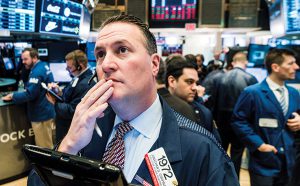Bloomberg
A semblance of calm returned to markets after the carnage sparked by hotter-than-expected American inflation that prompted investors to reassess the outlook for interest rates and economic growth.
US equity-index futures rallied about 0.5% after shares had their biggest drop in more than two years, with the S&P 500 falling more than 4% and the Nasdaq 100 sliding more than 5%. A gauge of the dollar retreated after jumping the most in three months on Tuesday. The 10-year Treasury yield ticked higher, hovering near a decade-peak.
While the magnitude of the equities rout was impressive, the S&P 500 only reversed gains made in the previous four sessions that had been fuelled by expectations of cooling inflation that would give the Federal Reserve room to temper its tightening path. The lack of a surge in the VIX index — known as the “fear gauge†— suggests that the selloff was a recalibration of those expectations rather than panic selling.
“Heading into the August CPI print, a number of traders thought they had information, and positioned very aggressively in the cash equity and
derivatives markets,†said Christopher Harvey, head of equity strategy at Wells Fargo. “It turns out they did not have any real information on CPI (only a hunch based upon recent trends), and now they do not have as much AUM.â€
Swaps traders are now pricing in a hike of three-quarters of a percentage point next week, with some wagers appearing for a full-point move. The two-year Treasury yield, the most sensitive to policy changes, rose two basis points after jumping as much as 22 basis points Tuesday, pushing it more than 30 basis points above the 10-year rate and deepening an inversion in what is generally a recession warning.
“An easing in inflationary pressure later this year will allow the Fed to broaden its focus again in order to manage the economic slowdown. However, we are not there yet,†said Mathieu Racheter, head of equity strategy at Bank Julius Baer. The Stoxx Europe 600 index slipped about 0.4%, though it pared a deeper drop as retailers gained, led by Inditex SA after the owner of the Zara fashion chain reported a jump in profit. Utilities were the among the worst-performing sectors as the European Commission considers plans to contain the energy crisis, which may include revenue caps.
Asian stocks and bonds tumbled in the wake of the broad-based selloff on Wall Street while the yen strengthened after Japan warned of possible intervention in the currency market. Equity indexes in Japan, Hong Kong and Australia slumped.
The greenback’s strength weighed on Asian currencies, with the Korean won among the big decliners. The People’s Bank of China set the daily reference rate for the yuan at the strongest bias on record versus the average estimate in a Bloomberg survey of analysts and traders. An index of emerging-market stocks fell 1.7%
Bitcoin nursed a drop of almost 10% overnight, the biggest decline since cryptocurrencies plunged in June.
Futures on the S&P 500 rose 0.5% in New York. Futures on the Nasdaq 100 rose 0.6%. Futures on the Dow Jones Industrial Average rose 0.4%. The Stoxx Europe 600 fell 0.4%. The MSCI World index fell 0.4%.
The Bloomberg Dollar Spot Index fell 0.3%. The euro rose 0.5% to $1.0016. The British pound rose 0.6% to $1.1560. The Japanese yen rose 1% to 143.12 per dollar.
The yield on 10-year Treasuries advanced two basis points to 3.43%. Germany’s 10-year yield was little changed at 1.73%.
West Texas Intermediate crude rose 0.3% to $87.54 a barrel.
 The Gulf Time Newspaper One of the finest business newspapers in the UAE brought to you by our professional writers and editors.
The Gulf Time Newspaper One of the finest business newspapers in the UAE brought to you by our professional writers and editors.
